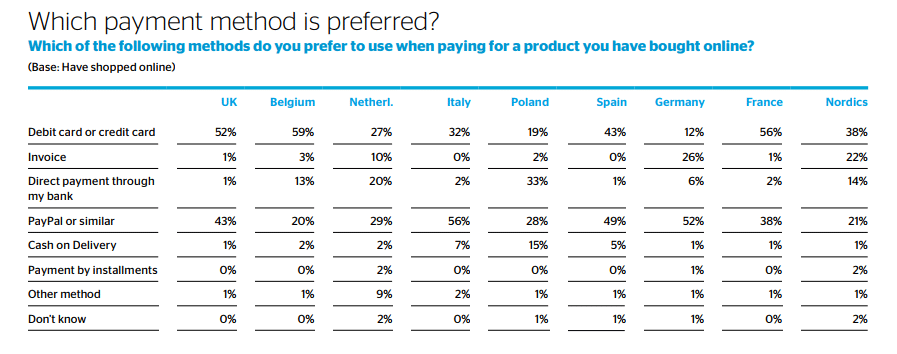From our previous post, you are already familiar that localization is not just about translating, not even about a grammatically perfect text covering all the writing conventions and dialects. Knowledge of the language is the key, but not the only thing you should be aware of before walking into a terra incognita. Culture and social life, legal norms, and financial issues – these are the fundamental stones to build a strong business in a specific locality.
What you not to miss out and what to focus on primarily? Let’s study the case of Europe.
Factors to consider before localizing
Target locale specifics
According to Statista, the internet connection is present in 85 percent of European households. Internet user penetration is high and headed by the United Kingdom. The UK is predicted to grow up to 95, France – to 81, and Germany – to 82 percent by 2021. The user penetration for mobile Internet is tending to increase. The 2016 stats show 70 percent for the UK, 66 percent – for France, and 63 percent – for Germany.
These figures show how mature the audience is in Europe. That’s why you should prepare more to deliver on expectations.
Website look and feel
Europe has been always dictating the game rules for design fusing the art and commerce concerns to get a perfect match. The European eCommerce design trend can be explained in three words: minimalism, reductionism, and eclecticism.
To get the general idea of a typical theme reflecting the Europe style you can take a look at our Airy Mobile Theme.
Social life
Thus, while examining the internet usage in Europe, take a closer look at social media. The most active social media penetration there was the highest in the Nordic countries, and lower in countries like Iceland and Malta. Russia is reported to gain 38.5 million monthly active mobile social media users as of in January 2017. A thing to consider is that 20 percent of the European mobile traffic belongs to YouTube. In this context, it would be rational to integrate a YouTube extension to showcase your video content right from your eCommerce platform.
Currency and payment
Currency
The EU currency is Euro. Read this list for full information about currencies in other European countries.
Payment and delivery
The two most popular payment methods are debit cards and payment services such as PayPal and others. They are safe and easy to use for the any-age consumer. Payment methods that have shown lower popularity are an invoice, cash on delivery (aka COD) and payment by installments. The stats may differ from country to country, but the averaged breakdown is as mentioned above. PayPal beats debit cards in Germany, Italy, and Poland. The reverse relates to the Nordic region, Belgium and France, and the equal ratio is characteristic for the UK, the Netherlands, and Spain. One more method to consider is direct bank transfer. It has grown recently but is very country-specific. Take the example of the Netherlands and Poland with a strong reliance on national payment services.
The most critical part of global eCommerce is securing the payment transaction. In order to deliver a secured and hosted international checkout, ensure that all transactions are legal and accepted in different currencies. We’ve got a secure payment gateway integrator for you.
Ensure the best international shipping rate to enter the local market and win competitors. Pay attention to all customs documentation and international shipping rules. You should be ready to study the case from the ground. The CS-Cart platform allows connecting method with its Stripe Payment Gateway add-on.



Source: PostNord.fi
Besides, the CS-Cart has got the most popular world-wide shipping systems out of the box: FedEx, DHL. Expanding to the Netherlands, you may examine PostNL. Anyway, to include all specific details, customization is likely the case as there is no uniform solution.
Business environment
Legal norms
The Europenean market differs less from US business environment as compared with China. However, there are still some peculiarities to take into account. Check the following if going europanise your online venture:
Some Europe-wide legal points to check out:
- Shopping rights
- Contract information
- Pricing and payments
- VAT
- VAT threshold registration
- Shipping and delivery
- Guarantees and returns
- Consumer rights
- Anti-spam regulations
For retailers who are interested in the EU market, GDPR compliance is the No.1 must-have. Don’t forget to enable the corresponding add-on on your website when expanding to the EU.
Key players on the market
Another key point to take into consideration when conquering the European market is competitor analysis. Let’s take a ride for the main eCommerce market holders in Europe.
Asos is based in the UK. It targets the young and sells over 80 000 products. The marketplace is also present in the U.S., Australia, Germany, France, Spain, Italy and Russia. Other UK based big marketplaces are DaWanda (for designers), Flubit, Fruugo (supporting 21 currencies and 17 languages), Tesco (grocery), Game (media products), and OnBuy.
Allegro is the biggest marketplace in Poland having 70 million monthly product sales and over 15 million customers.
Cel is based in Romania and offers free sign-up for vendors. Its sales are equal to 50k items annually, and the client base reaches 500 000. Other big players on the Romanian eCommerce are Emag (1k of daily visits), Okazii (3 million visitors monthly and 3k of daily).
Cdiscount is the marketplace located in France. This hodge-podge marketplace counts about 1 million unique visitors daily and has sales of 2 billion euros per year. Other France-based multi-vendors are Fnac (known for its omnichannel integration), and PriceMinister (Rakuten project).
Germany hosted many large marketplaces like Mobile.de, Otto, Real.de, Zalando.
And CS-Cart Multi-Vendor Plus platform continues adopting the rules of the game providing a framework that can be seamlessly customized to naturally fit the European market.
Closing
The European market is very potential but is also full of pitfalls. While planning entering the union, get consultancy with locals, especially concerning the laws. And the technical component of your eCommerce website is better to entrust to eCommerce developers experienced in customizing online shops for the needs and environment of a particular market.

